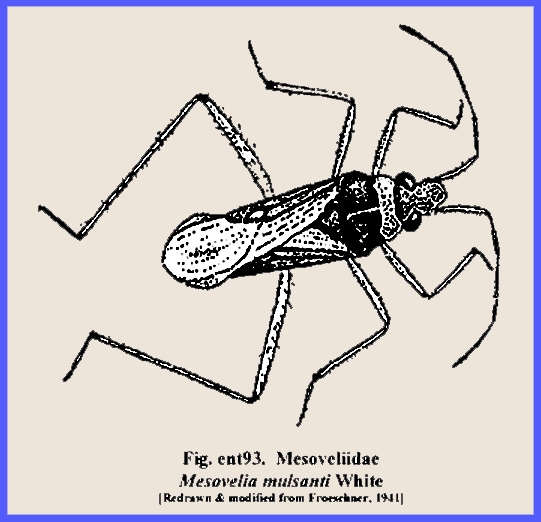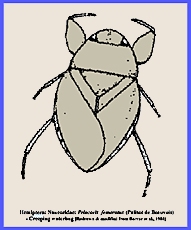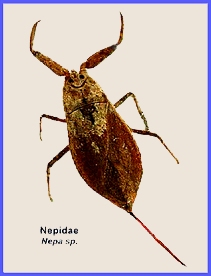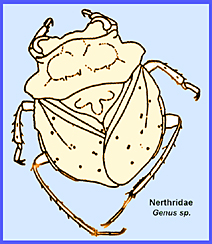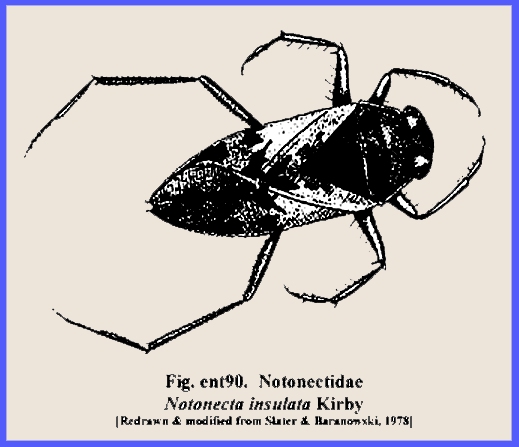File:
<hemiptrea.htm> Indexes: < (Entomology), (Invertebrates), (General
Index)> <Invertebrate Bibliography> <Glossary> <Site Description>
< Home>
|
Entomology: HEMIPTERA
1 Kingdom: Animalia, Phylum: Arthropoda Subphylum: Hexapoda: Class: Insecta: Order: Hemiptera (Contact) Please CLICK on underlined
categories to view and on included illustrations to enlarge: Depress
Ctrl/F to search for subject matter:
Hemiptera, meaning "half-wing",
are the true bugs that include many species
that are destructive to agricultural crops.
DNA evidence has shown a close relationship to the Homoptera, so that
the old classification under one group, Heteroptera, may eventually be
reinstated. They have one-half of their wings
leathery and rough, while the other half is membranous and soft. They are called hemelytra. Sometimes the leathery wings may be
reduced or absent. There is a rather
large scutellum. Metamorphosis is
simple as the nymphs have the same form as adults except for the lacking
wings. The mouthparts arise from the
front of the head and they possess true sucking mouthparts whereas other
insects that suck have modified mouthparts.
Their beak usually has 3-4 segments.
Plant feeding species suck plant juices whereas predatory species suck
blood from their hosts. The legs are typically the running type, equipped for rapid
movement. Predaceous species have
specialized forelegs for grasping.
Some species have legs modified for rowing. ------------------------------------------ The families of Hemiptera can be
divided into Land forms and Non-land forms depending on whether they are
terrestrial, aquatic or merely inhabit the water surface. Some of the most common species are
discussed and additional information on <Habits>,
<Adults> and <Juveniles>
is included when available.
Anthocoridae. -- <Habits>; <Adults> & <Juveniles> Barber (1936) gave an early account of the behavior of Orius
(= Triphleps) insidiosus Say in North
America. In corn this species was a
predator of Thysanoptera, Homoptera and to some extent Hemiptera, Lepidoptera
and Acarina. It was considered the
most important natural enemy of the corn earworm, Heliothis obsoleta
F., in certain areas of the United States.
Records from Virginia showed that the proportion of eggs destroyed
ranged from 14-54% during the season.
Young larvae were also attacked, though to a lesser extent (Clausen
1940/1962).
Pirate bugs average about 1.5 mm to 5 mm long. Their body is oval to triangular
and somewhat flattened, sometimes with a black and white patterned back.
Pirate bugs feed on other small insects, spider mites and insect eggs.
They cut a hole into their prey, pump saliva into it and drink the contents. This
makes them beneficial as biological control agents. Orius insidiosus,
the "insidious flower bug", for example, feeds on the eggs of the
corn earworm (Helicoverpa zea). Especially O. insidiosus is
often released in greenhouses against mites and thrips. These small insects can
bite humans, with surprising pain for such a small insect. However, they do
not feed on human blood or inject venom or saliva. In some people the bite
swells up, in others there is no reaction ------------------------------------------ Cimicidae. --
These are the bedbugs, which possess no wings
in any stage of development. They are
flattened insects that enable them to squeeze into fine crevices. They are blood feeders that favor tight
areas, under belts, etc. Of the more
than 45 species known, most feed upon birds, some upon bats and two species
upon humans. Bedbugs are nocturnal insects and
occur only where their hosts are present.
They require several meals of blood to complete their life cycle, and
when blood is unavailable they can stretch their life cycle. Some people develop a terrific rash while
others are rather insensitive. There
has been no disease associated with Cimicidae, but because of their severe
annoyance a quest for control led to the development of Rotenone as an insecticide. ------------------------------------------ Coreidae. -- Leaf footed bugs include the squash bug and box elder bug. This is a moderately
sized group whose species have well developed scent glands, which open on the
sides of the thorax. These give off a
distinctive odor when handled. All
are plant feeders and injurious to cucurbits and to some fruit crops. Some are a nuisance as household pests. Some coreids are brightly colored that often collect in
great numbers on trees and shrubs.
The box elder bug in Western North America can cause a nuisance from
the swarms that frequently occur. ------------------------------------------ Enicocephalidae. -- <Habits>; <Adults> &<Juveniles> These are the "Unique-headed" or "Gnat bugs." They are small, slender and predaceous
and are generally 4 mm
long, and occur worldwide. The head is elongated and somewhat
constricted.
The front wings are entirely membranous. In the United States there is a rare species, Systeloderes biceps (Say), which may be the only one. There are about 130 identified
species. Clausen (1940) made brief
mention of this family, stating that it was a relatively small group which
inhabited foliage and flowers and fed on a variety of insects in those
habitats. ------------------------------------------
Gelastocoridae. -- <Habits>; <Adults> & <Juveniles> The Gelastocoridae
or toad bugs contain about 105 species. They resemble toads by their warty
appearance and movements. These riparian insects occur at the margins of
streams and ponds, where they are predators of other insects. The family has
a worldwide distribution, with most species occurring in the tropics.
The following is derived primarily from Cassis et al. (2002):
Toad bugs average
6.1–11 mm long and have an ovoid body with roughened surface, frequently with
a warty appearance. The eyes are large, and protruding with ocelli usually being
present. The short antennae have four segments. The labium is 4-segmented and
does not extend beyond the forecoxae. The pronotum is large, transverse and
wider than the head. The scutellum is triangular and large. The metathoracic
scent glands are well developed in the Gelastocorinae, and absent in the
Nerthrinae. The larvae lack dorsal abdominal gland openings. The forewings
are mostly divided into clavus, corium and membrane. Menke (1979) reported
wing polymorphism as common, with flight rare, particularly in Nerthra Say
species. In some species the hemelytra are fused along the midline (Todd
1960). Parsons (1960) records a reduction in hind wings and wing musculature
in Gelastocoris Kirkaldy. The mid and hind legs are slenderand the
forefemora are incrassate. The foretarsi are diagnostic at the subfamily
level, the Gelastocorinae having a fully articulated, 1-segmented tarsus,
with the foretarsus and tibiae fused and a single claw on the pretarsus. The
pretarsi of the forelegs are asymmetrical, with the inner claw reduced. The
hind tarsus is 3-segmented. The abdominal sternites are asymmetrical,
particularly in the males. The male genitalia are asymmetrical with the left
paramere reduced or absent. The females lack a laciniated ovipositor (Parsons
1959, 1960; Slater 1982). ------------------------------------------ Lygaeidae. -- <Habits>; <Adults>
& <Juveniles> -- The "chinch bugs" belong to this family, which includes some brilliantly
colored and large species (e.g., milkweed bug). Extremely injurious they prefer to feed on seeds such as
cereals, especially wheat, and have been serious pests in Central North
America. The main symptom of injury
is a wilting and death of grain, especially maize. There are some predaceous species. Their size ranges from 1/4 to 3/8 inches long. The antennae have four segments. There are only four of five veins in the
wing. In cold climates they
overwinter in clumps of grasses as adults.
Adults migrate to grain fields in springtime and eggs are laid in the
boot of the plants. They will
emigrate to maize as nymphs, which cannot fly but must walk. The False
Chinch Bug will feed on most wild
plants in Western North America but will invade herbaceous crops if
present. Overwintering is usually in
the nymphal stage. ------------------------------------------ Miridae. -- <Habits>; <Adults>
& <Juveniles> -- The plant
bugs, Lygus spp. is a large family
with over 5,000 species known. They
feed primarily on plant juices and many are economic pests, and a few are
predaceous. They are fragile insects with drab
to brilliant coloration. The wing has
a unique appearance with two small cells, and the scutellum has a triangle on
its back. Mirids are very active and can run
and fly very rapidly. Several species
have taken up residence with ants.
They injure a wide variety of crops and are especially important on
alfalfa seed production, cotton, clover, celery and various fruits. Both nymphs and adults feed mainly on the
newly developed parts of plants and distort any fruit that might form. In Western North America they rank as one
of the most important economic insects. Overwintering is in the adult
stage. There are approximately four
generations per year, with 20-30 days per generation. ------------------------------------------ Nabidae. --
<Habits>;
<Adults>
& <Juveniles> -- Damsel bugs are
small, 3-11.5 mm in length, slender with their front femora somewhat
enlarged. They are all predaceous and
feed on many different kinds of insects.
Their color varies from yellow to brown with well-developed wings. ------------------------------------------ Pentatomidae. -- <Habits>; <Adults>
& <Juveniles> -- The true stinkbugs are one of the largest families in the order with a
worldwide distribution. They are
especially predominant in the tropics.
In North America many species are crop pests where they are very
destructive to alfalfa seed. The Say's Plant Bug is a green alfalfa feeder. All feed on herbaceous plats, sucking
juices. There is one predaceous
subfamily. These insects are flattened,
shield-shaped insects, 1/4 - 1/2 inch long usually. Many species have beautiful colorations, especially in tropical
areas. Antennae are 5-segmented, from
which the family derives its name (Penta
tomidae) ------------------------------------------ Phymatidae. -- <Adults> & <Juveniles> This is a group of small wide insects
with raptorial front legs. The front
femora are short and as broad as long.
The tibiae are minute and curved.
Most average 3-4 cm. long, but they are able to capture insects such
as large bumble bees, wasps, honey bees and house flies.. They locate their prey on flowers,
primarily goldenrod, where they are camouflaged. Insects in the subfamily
Phymatinae are called "ambush bugs" because they stalk prey while
camouflaged. They have raptorial
forelegs that are used in the capture process. Phymatinae are 5.1–12.3
millimetres long. In Phymata, the scutellum is triangular and shorter
than the pronotum. In Macrocephalus the scutellum is narrow and
rounded and extends to the tip of the abdomen. Most of these insects have a large
fore femur and clubbed antennae. The
forewing membranes sometimes lack
distinct cells. The antennae have 4
segments, and there are two ocelli. The beak and tarsi have 3 segments. The
posterior part of the abdomen extends beyond the wing margins. ------------------------------------------ Reduviidae. -- <Habits>; <Adults>
& <Juveniles> -- These are the assassin
bugs
and kissing
bugs. Their beak lies back between their legs in
a groove called the stridulatory groove.
When the beak is rubbed against the groove a squeaking sound is
produced. All members of this family are
predaceous and bloodsuckers. The group
has very harmful aspects, as some species are important medically as vectors
of very serious human diseases. In
tropical America Chagas
Disease, caused by trypanosomes
is vectored by assassin bugs. Their
bite is very painful due to their toxic saliva. They may even enter dwellings to feed upon bed bugs and other
insects. ------------------------------------------ Termitaphididae. -- These insects are known as "Termite bugs." The family is small occurring in the
tropics worldwide. Individuals of
Termitaphididae are small, averaging 2-4 millimetres. They are flattened with plates extending out from each body to produce a
round scale like appearance. There
are two genera and twelve known species.
They are are also inquilines that occur in the nests of termite families Termitidae and Rhinotermitidae. Though considered a separate family in Aradoidea it has been
suggested that Termataphididae may in fact be highly derived members of Aradidae. Of the known species one Termitaphis
circumvallata belongs to the monotypic genus Termitaphis and four
of the remaining eleven species in Termitaradus are extinct, having only been known from amber
deposits. Living species occur
worldwide in the tropical regions of Central and South America, Africa, Asia,
and Australia. ------------------------------------------ Tingidae. -- These
are lace
bugs, whose body's dorsal
surface shows a very find network of veins, which gives it a delicate lace
pattern. The immature stages differ
from the adult in possessing many spines. All species are plant feeders,
preferring to reside on the undersides of leaves. Some form galls on the leaves and many cause some defoliation. For a long time this group was
believed to be ancestral to land, but this has now been considered
false. Certain predatory forms
inhabit a shore or littoral environment.
Many species are able to spend only a part of their life in
water. Some are able to live on the
water surface. Special modifications have enabled
them to exist in aquatic environments.
They have developed special breathing apparatus, some lost the
predatory habit and feed only on plants, and some have had their legs modified
so that they do not sink into the water itself. ------------------------------------------ Belostomatidae. --
<Habits>; <Adults> & <Juveniles> -- Giant water bugs have a flattened
form facilitates movement. Most are
brownish and leathery in appearance and are found in quiet water or in
streams. Their front legs are
modified for the predatory habit, and they are very aggressive and active
swimmers. Insects, frogs and fish are
included in their diet. Belostomatids have the habit of
feigning death when captured, and they can inflict painful bites. Their eggs are laid on vegetation
or glued to objects in water, usually in masses containing up to 100
eggs. Oftentimes the female lays eggs
on the back of the male. The glue is
water insoluble. In the water they breathe by means
of a breathing tube. Retractile appendages at the end of the
abdomen lead to spiracles on the 6th abdominal segment. Air reservoirs are also present. They have nocturnal flight habits
and are attracted to light. They can
be a nuisance in tropical areas when they infest buildings. ------------------------------------------ Berytidae (Neididae). -- This is
a small family of thread-legged hemipteran insects in the superfamily
Lygaeoidea. Species are slender and
delicate with very long legs and antennae.
The apex of the first segment of the antennae, and apices of the femora,
are clavate; terminal segment of antennae enlarged and fusiform; antennae four-segmented
and tarsi three-segmented. The head
is usually equipped with a transverse dorsal sulcus immediately anterior to
ocelli, and continued laterally to the hind margin of the eyes. The pronotum dorsally and laterally, and
the subcoxae are covered with a raised net-like reticulation enclosing
punctuations. ------------------------------------------ Corixidae. -- Water
boatmen are very widespread and
probably the most abundant of the Hemiptera.
Different species prefer certain kinds of water. They have a very interesting wing pattern,
which is black and white with a barred effect. Their size is 1/4 to 3/4 inches in length, and their coloration
is protective. Their legs are
modified for rapid movement in water.
Ent91 This is the only aquatic group
that is not predaceous, as it feeds on algae with some exceptions. The larvae also feed on minute vegetable
material by scooping it into their mouths.
They have spatulate tarsi.
Some may feed on mosquito larvae.
They are short-lived insects.
Specialized masticating structures are present. Many corixids are very active at
night. ------------------------------------------ Gerridae. --
<Habits>;
<Adults>
& <Juveniles> -- Water striders
have long slender
legs. Body hairs repel water and
their claws have been reposition from apical to pre-apical so that the
surface film of the water is not broken.
The hind legs are for steering, while the front legs are held under
the head and shorter then the rest.
They hold their prey with their front legs, and pierce and suck out
the liquid contents. Tropical members of this insect
group exist in the marine habitat and can be found
a few hundred kilometers out at sea. ------------------------------------------ Mesoveliidae.
-- Water Treaders occur on floating
vegetation at the edges of pools or ponds or on logs that project from
water. They can run rapidly over the
water surface. Their size ranges up
to only 5 mm in length. They are
slender insects and usually green or yellow in color. Adults may be either winged or
wingless. They are all predaceous on
small aquatic organisms that occur near the surface of water. ------------------------------------------ Naucoridae. -- <Habits>; <Adults> & <Juveniles> This is a small family
of insects species of which are the
creeping water bugs.
Originally this family was placed in the Naucoroidea with the
Aphelocheiridae and Potamocoridae.They are similar in appearance and behavior
to the Belostomatidae, as they also occur in ponds and other quiet waters.
Sometimes, these insects also occur
found in damp places in dwellings, and are frequently believed to be
cockroaches. There are about 22 genera in 5 subfamilies, with worldwide
distribution. Their body shape makes them look like smaller
Belostomatidae . They have raptorial forelegs for catching and holding their prey. Their small antennae located under the eye are often
difficult to discern. Similar to the
Giant Water Bugs they have a cylindrical beak of 3 or 4 segments.
------------------------------------------ Nepidae. -- <Juveniles> These are the water scorpions, their superficial resemblance to a scorpion,
which is due to the raptorial forelegs and the presence of a long slender
process at the posterior end of the abdomen, simulating a tail. There are 14 genera in in two subfamilies,
Nepinae and Ranatrinae. Species of the genus Ranatra are referred to
as needle bugs or water sticks because they are thinner than Nepa and
its allied genera. All species are predaceous aquatic bugs with raptorial
front legs. They have a long caudal
breathing tube that is derived from their cerci. This tube is often as long as the body, and is held at the
surface as the insect crawls over aquatic vegetation They move quietly and feed on small
aquatic animals. They may inflict
painful bites on humans. They do not
usually fly although wings are funcitonal.
The eggs are laid in the tissues of aquatic plants. Waterscorpions feed mainly
on invertebrates, but sometimes will even consume small fish or tadpoles.
Respiration in the adult is through the caudal process, which consists of a
pair of half-tubes that are locked
together to form a siphon. In immature forms the siphon is undeveloped and
breathing takes place through six pairs of abdominal spiracles. The eggs, which are laid above the
waterline in mud, decomposing vegetation, the stems of plants or rotting
wood, are supplied with air by filamentous processes which vary in number
among the genera. ------------------------------------------ Nerthridae (= Galgulidae). -- The "Toad Bugs" are broad, squat and with prominant
eyes. They are predators living in
swamps and along stream banks. There is
no known economic importance. Galgulus is a common genus found. ------------------------------------------ Notonectidae. -- <Habits>; <Adults>
& <Juveniles> -- The backswimmers have
a keel-shaped appearance somewhat like a boat. They swim up side down.
They rest on water, their legs extended as oars that have fringes of
hairs, which allow them to propel themselves rapidly. These insects are difficult to capture as
they are very agile and dive rapidly into the water. They inhabit streams and lakes. Some species are brightly colored. They suck the juices of plants and will
travel long distances to water. ------------------------------------------ Ochteridae . -- <Habits>; <Adults> & <Juveniles> These are the velvety shore bugs. They derive their name from a velvety appearance. There are about 26 identified species. They are egg-shaped and 3-5.5 mm. long. They occur along the banks of streams and ponds and also in
sandy or muddy places near to shallow water.. Their color is blue or black, and they are are all considered
predaceous. Clausen (1940) noted that
they are littoral in habit and feed on insects and other small animals around
the muddy margins of ponds and streams. Habit: Commonly known as ‘velvet shore bugs’, they are
cryptically colored, run quickly over sunlit open ground and jump or fly
short distances. The nymphs of some species are slow moving and so camouflage
themselves by scooping sand onto their dorsum using a small comb on the
anterior portion of the head, just over the labrum, and positioning it using
the fore- and hindlegs.
------------------------------------------ Saldidae. -- <Habits>; <Adults> & <Juveniles> These are known as shore bugs, and are a
family of insects in the order Hemiptera (true bugs). They are
oval-shaped and measure 2.1 8.2 mm long when mature. They are usually
found near shorelines or the marginal growths near water. They are able to
escape harm by leaping or taking flight. ------------------------------------------ Vellidae. -- <Habits>; <Adults> & <Juveniles> Veliidae is a family of predatory
insects in the order Hemiptera. They are also known as riffle bugs, smaller water striders or broad-shouldered water striders due to the segment just behind
the head being wider than the rest of the abdomen. This differs from the typical water striders (Gerridae), which
are close relatives that are also in superfamily Gerrioidea. Unlike some
Gerridae, riffle bugs are small and usually about 4.4 mm. long. ------------------------------------------ = = = = = = = = = = = = =
= = = = = = = Hemiptera --Biological Control Projects (1%
of total projects) Green Vegetable Bug, Nezara viridula (L.) <ch-58.htm>
============== References & <biology.ref.htm>, [Additional
references may be found at: MELVYL Library ] |
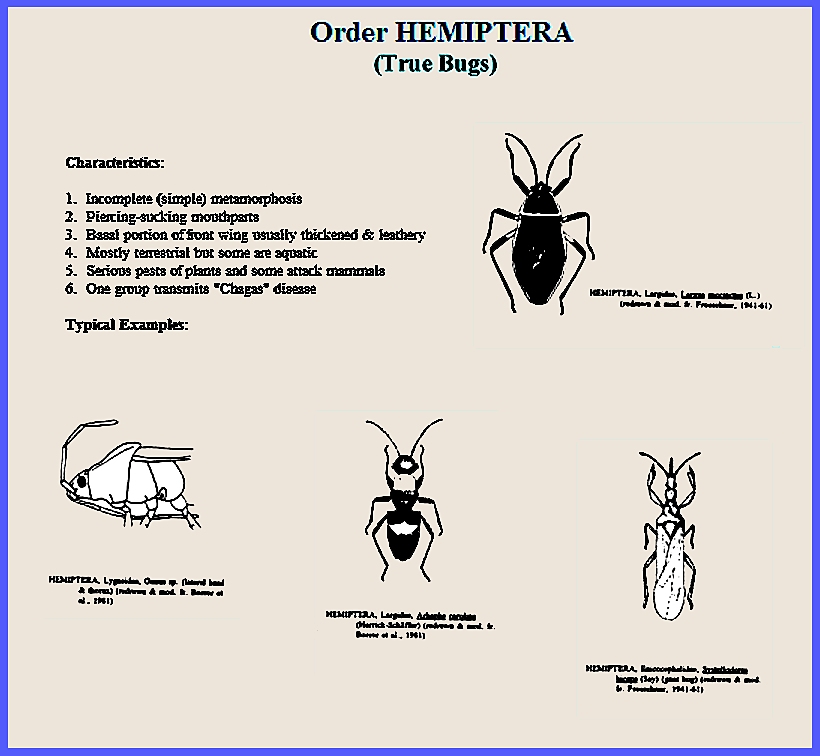
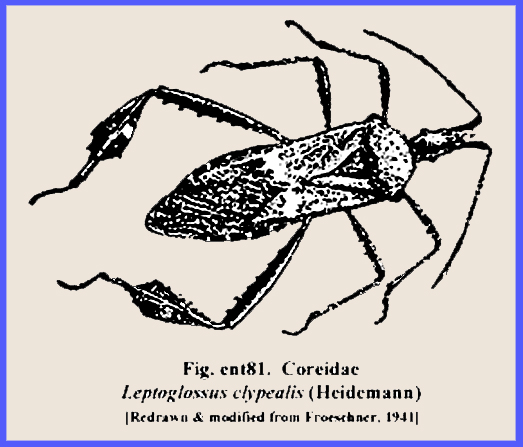

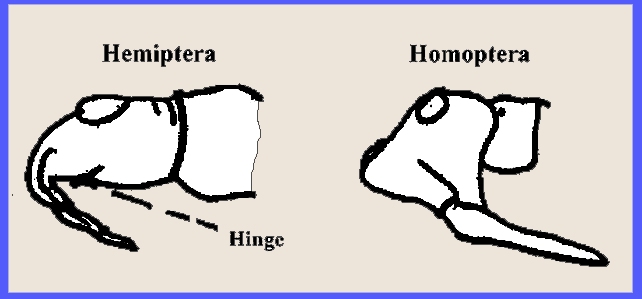
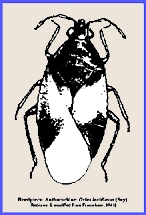

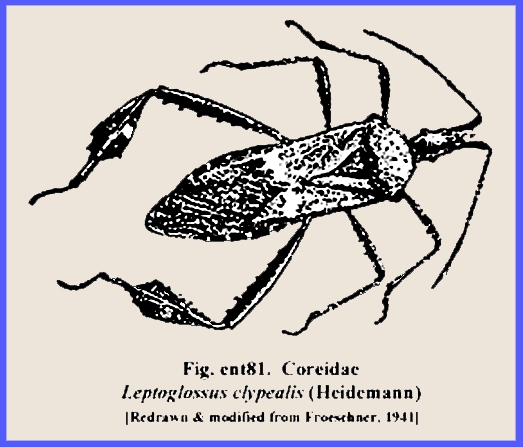
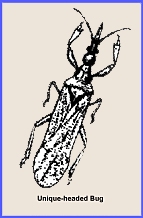
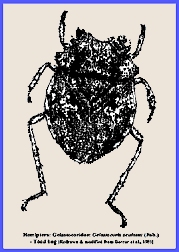
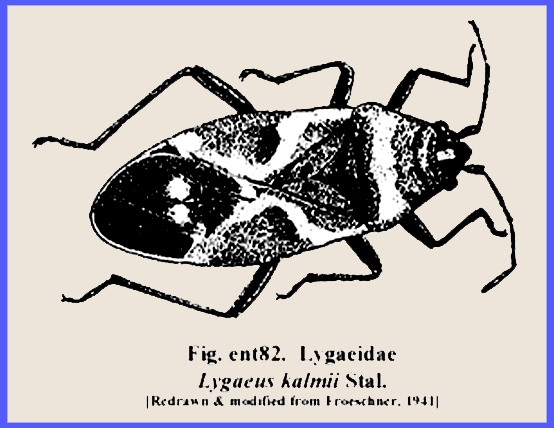
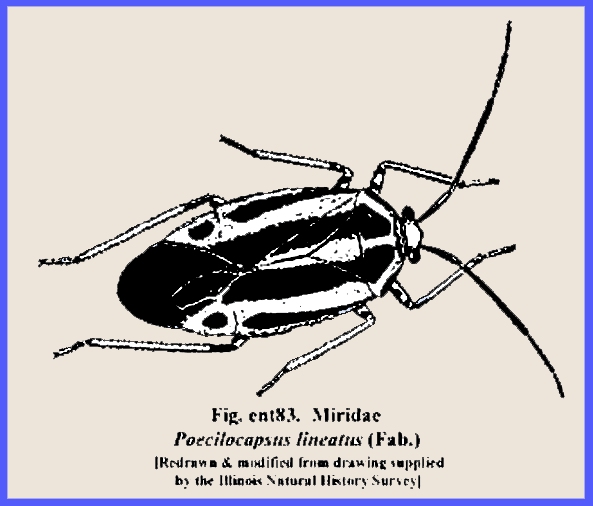
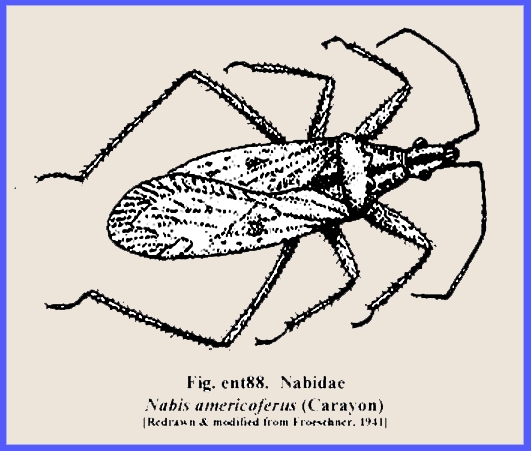

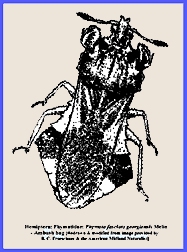
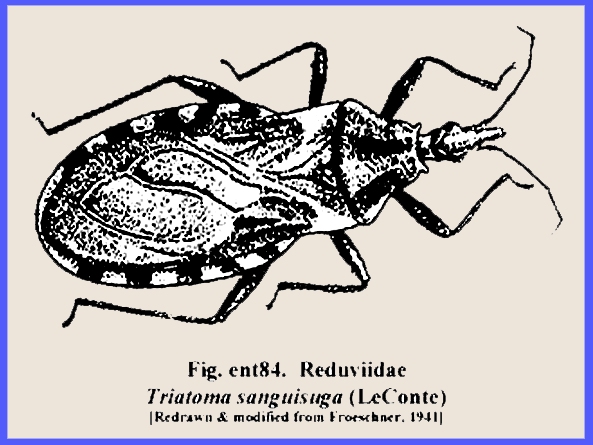
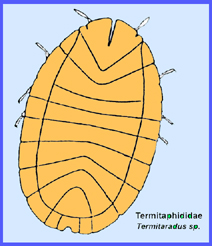

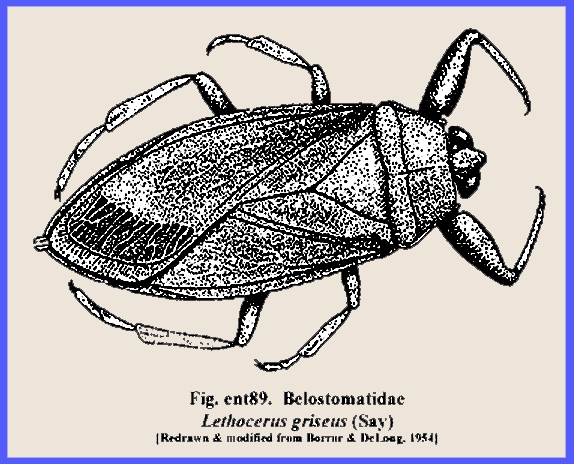
0.jpg)

